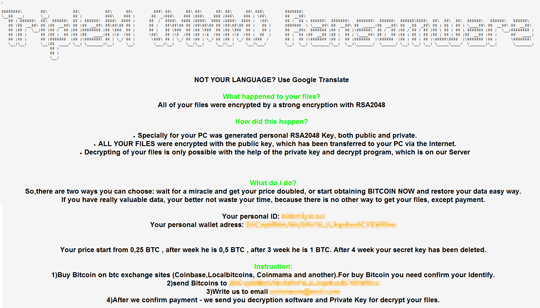RANSOM_MMM.A
HEUR:Trojan-Ransom.Win32.Generic (KASPERSKY); Trojan.Gen.2 (NORTON); Mal/TripM-A (SOPHOS_LITE)
Windows


Threat Type: Ransomware
Destructiveness: No
Encrypted: No
In the wild: Yes
OVERVIEW
This Ransomware arrives on a system as a file dropped by other malware or as a file downloaded unknowingly by users when visiting malicious sites.
It executes then deletes itself afterward.
It encrypts files with specific file extensions. It drops files as ransom note.
TECHNICAL DETAILS
Arrival Details
This Ransomware arrives on a system as a file dropped by other malware or as a file downloaded unknowingly by users when visiting malicious sites.
Installation
This Ransomware drops the following files:
- %User Temp%\changelog.txt - contains information that OS is simulating
- {malware path}\key_{random 8 characters}.{random 3 characters}.mmm - contains the RSA key value
(Note: %User Temp% is the user's temporary folder, where it usually is C:\Documents and Settings\{user name}\Local Settings\Temp on Windows 2000, Windows Server 2003, and Windows XP (32- and 64-bit); C:\Users\{user name}\AppData\Local\Temp on Windows Vista (32- and 64-bit), Windows 7 (32- and 64-bit), Windows 8 (32- and 64-bit), Windows 8.1 (32- and 64-bit), Windows Server 2008, and Windows Server 2012.)
It drops and executes the following files:
- %Application Data%\temp_1.bat - quietly delete all shadow volume copies
- %Application Data%\reco.bat - disables Windows recovery mode
- %Application Data%\bcedit.bat - disables Windows startup repair
(Note: %Application Data% is the Application Data folder, where it usually is C:\Documents and Settings\{user name}\Application Data on Windows 2000, Windows Server 2003, and Windows XP (32- and 64-bit); C:\Users\{user name}\AppData\Roaming on Windows Vista (32- and 64-bit), Windows 7 (32- and 64-bit), Windows 8 (32- and 64-bit), Windows 8.1 (32- and 64-bit), Windows Server 2008, and Windows Server 2012.)
It executes then deletes itself afterward.
Other Details
This Ransomware does the following:
- Execute the following commands:
- vssadmin.exe delete shadows /all /quiet
- bcdedit.exe /set {default} recoveryenabled No
- bcdedit.exe /set {default} bootstatuspolicy ignoreallfailures
- RESTORE_triple_m__FILES.html displays the following:

Ransomware Routine
This Ransomware encrypts files with the following extensions:
- .dis
- .adx
- .fp7
- .sif
- .ldf
- .ndf
- .mdf
- .trn
- .err
- .myi
- .myd
- .zip
- .bak
- .bkf
- .prn
- .data
- .ctf
- .mkd
- .ziz
- .pxf
- .dst
- .eps
- .tlf
- .ltf
- .cdr
- .pmd
- .ai
- .txt
- .qbw
- .qbb
- .tlg
- .ecw
- .frm
- .pix
- .accdb
- .mdb
- .cdr
- .eps
- .tif
- .msg
- .asmx
- .rpt
- .arw
- .qbo
- .qbw
- .sldprt
- .dwf
- .doc
- .adi
- .adt
- .docx
- .altr
- .xls
- .xlsx
- .ppt
- .pptx
- .odt
- .jpg
- .png
- .csv
- .sql
- sln
- .php
- .asp
- .aspx
- .html
- .xml
- .psd
- .bat
- .js
- .css
- .sqlite
- .dwg
- .jpeg
It appends the following extension to the file name of the encrypted files:
- .triple_m
- .info
It drops the following file(s) as ransom note:
- {Encrypted file path}\RESTORE_triple_m__FILES.html
SOLUTION
Step 1
Before doing any scans, Windows XP, Windows Vista, and Windows 7 users must disable System Restore to allow full scanning of their computers.
Step 2
Note that not all files, folders, and registry keys and entries are installed on your computer during this malware's/spyware's/grayware's execution. This may be due to incomplete installation or other operating system conditions. If you do not find the same files/folders/registry information, please proceed to the next step.
Step 3
Identify and terminate files detected as RANSOM_MMM.A
- Windows Task Manager may not display all running processes. In this case, please use a third-party process viewer, preferably Process Explorer, to terminate the malware/grayware/spyware file. You may download the said tool here.
- If the detected file is displayed in either Windows Task Manager or Process Explorer but you cannot delete it, restart your computer in safe mode. To do this, refer to this link for the complete steps.
- If the detected file is not displayed in either Windows Task Manager or Process Explorer, continue doing the next steps.
Step 4
Search and delete this file
- {Encrypted file path}\RESTORE_triple_m__FILES.html
Step 5
Scan your computer with your Trend Micro product to delete files detected as RANSOM_MMM.A. If the detected files have already been cleaned, deleted, or quarantined by your Trend Micro product, no further step is required. You may opt to simply delete the quarantined files. Please check the following Trend Micro Support pages for more information:
Step 6
Restore encrypted files from backup.
NOTES:
- Enable services disabled using the command prompt.
- Run cmd.exe as administrator.
- To enable Windows Error Recovery Screen on Startup use the following command: bcdedit /set {default} bootstatuspolicy displayallfailures
- To enable Startup Repair use the following command: /bcedit /set {default} recoveryenabled Yes
Did this description help? Tell us how we did.


